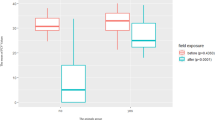Summary
Three spleen cell lines derived from 3 calves experimentally infected withTheileria parva have been established. After an apparent disappearance of parasitized cells from the cultures there was a resurgence of infected lymphoblasts in 5 to 6 weeks. The infected lymphoblasts can be readily subcultured without feeder layers in a medium consisting of Eagle’s Minimal Essential Medium and 20 per cent foetal calf serum. The plating of infected cells was greatly enhanced by implanting the cells on preformed monolayers. No evidence was obtained by the methods employed which might indicate the existence of an extracellular form of the parasite capable of reinfecting new cellsin vitro.
Résumé
Trois lignées de cellules de rate issues de trois veaux expérimentalement infectés parTheileria parva ont été établies. Après une apparente disparition des cellules parasitées dans les cultures, il y avait une résurgence de lymphoblastes infectés au bout de 5 à 6 semaines.
Ceux-ci pouvaient être mis en subculture aisément sans couche de soutien dans un milieu constitué du M.E.M. de Eagle, enrichi par 20 p. 100 de sérum de foetus de veau. L’étalement des cellules infectées était grandement facilité par leur implantation sur des couches préformées. Par les méthodes employées, on obtient aucune preuve de l’existence d’une forme extracellulaire du parasite, capable de réinfecterin vitro des cellules neuves.
Sumario
Se han establecido 3 lineas celulares de bazo derivadas de tres terneros experimentalmente infectados conTheileria parva.
Despuéś de una aparente desaparición de las células parasitadas de los cultivos, hubo una resurgencia de linfoblastos infectados en 5–6 semanas. Los linfoblastos infectados pueden ser subcultivados facilmente sin capas alimentadoras en un medio consistente de Eagles, medio mínimo esencial enriquecido con 20 por ciento de suero bovino fetal. El plaqueo de las células infectadas fue grandemente estimulado mediante la implantación de das células en monocapas previamente formadas. Con los métodos utilizados no se obtuvo evidencia para indicar la existencia de una forma extra celular de el parásito capaz de reinfectar neuvas célulasen vitro.
Similar content being viewed by others
References
Brocklesby, D. W. &Hawking, F. (1958). ‘Growth ofTheileria annulata andT. parva in tissue culture’.Transactions of the Royal Society of Tropical Medicine and Hygiene,52, 414–420.
E.A.V.R.O. Annual Report (1968). p. 24–61. East African Veterinary Research Organization, Muguga, P.O. Kabete, Kenya.
Hulliger, L. (1965). ‘Cultivation of Three Species of Theileria in Lymphoid Cellsin vitro’.The Journal of Protozoology,12, 649–655.
Hulliger, L., Wilde, J. K. H., Brown, C. G. D. &Turner, L. (1964). ‘Mode of multiplication of Theileria in cultures of bovine lymphocytic cells’.Nature, London,203, 728–730.
Malmquist, W. A., Van Der Maaten, M. J. &Boothe, A. D. (1969). ‘Isolation, Immunodiffusion, Immunofluorescence, and Electron Microscopy of a Syncytial Virus of Lymphosarcomatous and Apparently Normal Cattle’.Cancer Research,29, 188–200.
Pipano, E. &Tsur, I. (1965). ‘Experimental Immunization AgainstTheileria annulata with a Tissue Culture Vaccine. I. Laboratory Trials’.refuah Veterinarith,23, 194–186.
Tsur, I. Neitz, W. O. &Pols, J. W. (1957). ‘The development of Koch bodies ofTheileria parva in tissue cultures’.Refuah Veterinarith,14, 53.
Wilde, J. K. H. (1967).Advances in Veterinary Science, Vol.11, 207–259. New York and London: Academic Press.
Author information
Authors and Affiliations
Rights and permissions
About this article
Cite this article
Malmquist, W.A., Nyindo, M.B.A. & Brown, C.G.D. East coast fever: Cultivationin vitro of bovine spleen cell lines infected and transformed byTheileria parva . Trop Anim Health Prod 2, 139–145 (1970). https://doi.org/10.1007/BF02359680
Accepted:
Issue Date:
DOI: https://doi.org/10.1007/BF02359680




